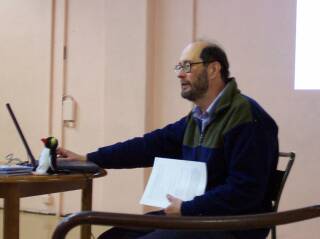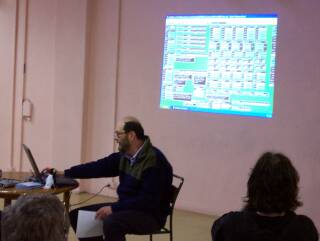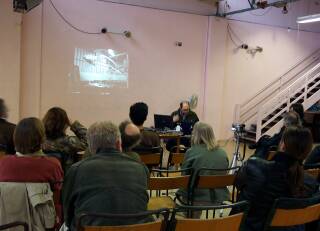


Warren Burt - The Wilson Installations
(This extract from the composer's lecture notes temporarily replaced John Jenkins' web review which appeared in December 2004. It is kept here for archival purposes.)
The Wilson Installations are a set of three very large scale live solo electronic music performance installations that deal with the notions of extended tuning systems, the relation of tuning to timbre and spatiality of sound, concentration of attention for extended time periods, site specific installation and performance, live interaction with algorithmic generation of melody and harmonic choices, and the notion of the artist (or at least this artist) re-gaining control over the presentation and production of their own works.
The works were written between 2000 and 2004, and the initial impetus for each one came from certain music theory articles by Ervin M. Wilson, musicologist and music scale theorist of Los Angeles. The works are The MOSsy Slopes of Mt. Meru: The Meru Expansion (2000-2004) for two laptop computers and two synthesizers; Pythagoras' Babylonian Bathtub (2003) for three laptop computers and three synthesizers; and Saturday in the Triakontahedron with Leonhard " (2000-2004) for one laptop and one software synthesizer. Each work lasts a minimum of one hour, and preferably much longer, although shorter versions have been performed.
The large-scale nature of the works came about for a number of reasons. Firstly, each work originated in researches into certain tuning systems proposed by Ervin Wilson. Each of these systems:
- the Meru Prastala, also known as Pascal's Triangle;
- the Scale Tree of Charles Peirce;
- and the Euler-Fokker Genus 3 5 7 9 11 13;
These pieces were a return to long duration for me. I had done long duration pieces in the past, but more recently had been an enthusiastic participant in the improvised music "scene." But as I believed that the nature of the music should dictate the nature of the performance space and manner of presentation, and not vice versa, I found that these harmonic ideas of mine just didn't fit into the 10-20 minute "sets" of the variety show concept that had developed in the Melbourne improvisation scene. Nor did I feel that the pieces would fit in the contemporary computer music scene, which favoured large scale presentations on institutionally installed multi-loudspeaker setups.
I've always felt that artists should be in control of the means of production, performance and dissemination of their work. In terms of technology, this has led me to the ideal of personally owning all the equipment necessary for the performance of the piece at hand. And if economic conditions meant that large equipment was not affordable, ways of working with cheaper equipment to produce the desired result should be found.
These pieces also have a unique form - what I call a performance installation. That is, the works are very long, and live in a particular space for a long time period - preferably hours, if not days. However, I interact with the computers, making decisions about the shaping of the sound, so they're also performances.
Four questions present themselves here:
- Why did I get into tuning?
- Why did I get into live electronic music performance?
- Why did I get into process (or algorithmic) composition?
- Why did I evolve the self-reliant (or small-scale) performance ethic?
I got into live electronic music performance because it was something I could do myself, and because, when I first learned electronics - in the late 1960s - there were just so many possibilities available with electronics that acoustic instruments couldn't do, that it almost instantly became my native compositional language.
Algorithmic composition was first shown to me by Joel Chadabe in the late 60s. The combining of control voltages on the early synthesizers to make musical patterns that were otherwise unavailable was an impetus to further investigation, as was contact with composers who were using processes to generate their music, such as John Cage, Cornelius Cardew, Salvatore Martirano, and Chadabe himself.
Finally, the idea of the self-reliant composer was first suggested to me by Kenneth Gaburo, who pointed out that I should own my own equipment, as it was unlikely that I would have access to institutional facilities forever. Later, in Melbourne, work with composers such as Ron Nagorcka and Ernie Althoff on the development of a low-budget ethic refined and developed this idea, with a slightly more political edge than it had had in California.
Each of the three pieces is performed on laptop computers, using software and hardware synthesizers. The computers are set up on a table in the middle of the room, and sound is heard through a small portable sound system. Generally, there have been two larger and two smaller loudspeakers. The aim of these has been to spread the sound evenly throughout the space, so that the effect of the space itself on the sound played can be heard clearly. There is not much panning or directing of sound to any particular position in space. I'm wanting the feel of the sound in space to actually be a product of the interaction of my sounds and the space itself. Each family of scales was generated from a particular mathematical diagram or phenomenon. In each piece, a different process, involving some elements of randomness, was used to choose which pitches were playing when in what combinations. Some people may call this a new Pythagoreanism, in that it deals heavily with number and the concept of music being number made audible. There may be an element of truth to this, but I feel that because I'm doing all this to obtain and explore certain qualities of sound, then I'm not as involved with the mystical nature of number as the historical Pythagoreans were. For me, in these piece, the idea of serious listening to very subtly different shades of sound is paramount, and it shaped my choice of structures and how and where I choose to present them.
